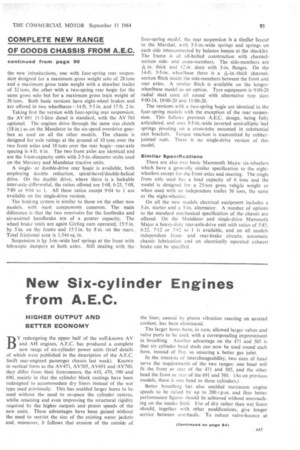New Six-cylinder Engines from A.E.C.
Page 95

If you've noticed an error in this article please click here to report it so we can fix it.
HIGHER OUTPUT AND BETTER ECONOMY BY redesigning the upper half of the well-known AV and AH engines, A.E.C. has produced a complete new range of six-cylinder power units (brief details of which were published in the description of the A.E.C. Swift rear-engined passenger chassis last week). Known in vertical form as the AV471, AV505, AV69I and AV760, they differ from their forerunners, the 410, 470, 590 and 690, mainly in that the cylinder block castings have been redesigned to accommodate dry liners instead of the wet type used previously. This has enabled larger bores to be used without the need to re-space the cylinder centres, whilst retaining and even improving the structural rigidity required by the higher outputs and piston speeds of the new units. These advantages have been gained without the need to restrict the size of the existing water jackets and, moreover, it follows that erosion of the outside of
the liner, caused by piston vibration reacting on aerated coolant, has been eliminated.
• The larger bores have, in turn, allowed larger valves and valve ports to be used, with a corresponding improvement in breathing. Another advantage on the 471 and 505 is that six cylinder head studs can now be used round each bore, instead of five, so ensuring a better gas. joint.
In the interests of interchangeability, two sizes of head serve the requirements of the two ranges: one head will fit the front or rear of the 471 and 505, and the other head the front or rear of the 691 and 760. (As on previous models, there is one head to three cylinders.) Better breathing has also enabled maximum engine speeds to be raised by up to 200 r.p.m. and thus better performance figures should be achieved without encroaching on the smoke limit. Use of dry rather than wet liners should, together with other modifications, give longer service between overhauls. To reduce valve-bounce at




















































































































































